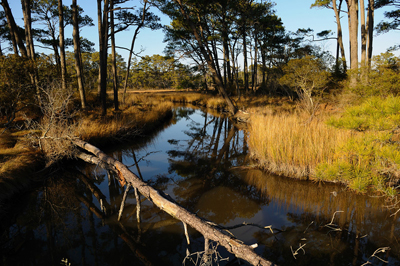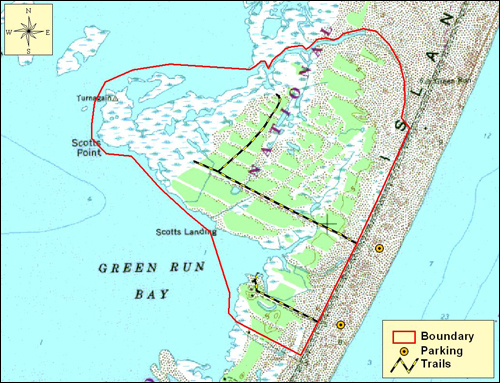Green Run Woods, Worcester County
 On Assateague Island the only constant is change. Some changes occur rapidly; others take much longer. In the 1860s, long before the existence of the Ocean City Inlet, Green Run was an inlet; it is estimated it allowed as much water flow as the Ocean City Inlet does today. Nature closed Green Run Inlet by 1880, but not before creating the land that now forms Green Run Woods and the marsh islands out to Whittington Point. The coastal processes that formed and closed Green Run Inlet set the stage for the development of Maryland's finest example of old growth Maritime Forest. The loblolly pines of Green Run Woods are some of the oldest in Maryland. If not for the growth-limiting effects of salt spray and poor soil, these modest pines would be towering giants. Although humans made regular use of Assateague Island in the 19th and early 20th centuries, their impacts were limited, are now difficult to detect, and have nearly disappeared. Green Run Woods Natural Area is as near to untouched as one can get on Assateague Island. In addition to the old growth forest, the Natural Area contains excellent examples of maritime scrub, salt marsh and inter-dune wetland swales between the now-forested former dunes.
On Assateague Island the only constant is change. Some changes occur rapidly; others take much longer. In the 1860s, long before the existence of the Ocean City Inlet, Green Run was an inlet; it is estimated it allowed as much water flow as the Ocean City Inlet does today. Nature closed Green Run Inlet by 1880, but not before creating the land that now forms Green Run Woods and the marsh islands out to Whittington Point. The coastal processes that formed and closed Green Run Inlet set the stage for the development of Maryland's finest example of old growth Maritime Forest. The loblolly pines of Green Run Woods are some of the oldest in Maryland. If not for the growth-limiting effects of salt spray and poor soil, these modest pines would be towering giants. Although humans made regular use of Assateague Island in the 19th and early 20th centuries, their impacts were limited, are now difficult to detect, and have nearly disappeared. Green Run Woods Natural Area is as near to untouched as one can get on Assateague Island. In addition to the old growth forest, the Natural Area contains excellent examples of maritime scrub, salt marsh and inter-dune wetland swales between the now-forested former dunes.
The forests of Green Run Woods support a wide variety of bird species not found at most other locations on Assateague Island. The Natural Area was the first location on Assateague reoccupied by nesting bald eagles as they recovered from the declines of the DDT era. A pair of red-tailed hawks nests within Green Run Woods, the only location where they are known to nest on Assateague. Brown-headed nuthatches, red-eyed vireos, blue jays, Carolina chickadees and other traditional mainland forest birds that are nearly non-existent on other parts of Assateague, were recorded as probable breeders within Green Run Woods Natural Area during the 2nd Maryland and DC Breeding Bird Atlas. This area is managed by the National Park Service as part of Assateague Island National Seashore

It’s Dynamic, Baby!
 As a result of the sand moving through the former inlet, the Maryland portion of Assateague Island reaches its widest point at Green Run Woods, just over two miles from the beach to Whittington Point. This process of sand movement and deposition occurred numerous times throughout history; each time the island was breached and an inlet formed. Just north of Green Run Woods lies the Fox Hill Levels. During major storms, waves overwash Assateague at this low flat area. Visitors can spot this area and other former inlets while traveling along the beach.
As a result of the sand moving through the former inlet, the Maryland portion of Assateague Island reaches its widest point at Green Run Woods, just over two miles from the beach to Whittington Point. This process of sand movement and deposition occurred numerous times throughout history; each time the island was breached and an inlet formed. Just north of Green Run Woods lies the Fox Hill Levels. During major storms, waves overwash Assateague at this low flat area. Visitors can spot this area and other former inlets while traveling along the beach.
Ditching and Wetlands Don't Mix
Like most salt marshes on Assateague Island, those in the western portion of the Natural Area were ditched during the early 20th century in an attempt to control mosquitoes. At the time, this seemed like a good idea. In the long run however, the ditches failed to control the mosquito population and degraded the water flow (hydrology) and natural functioning of the marsh. The National Seashore is currently filling in the ditches to return marsh hydrology to more natural conditions. The restoration of hydrology in these salt marshes will improve the integrity and sustainability of the wetland communities in the western portion of Green Run Woods Natural Area.
Click here for a Print Version of this map.

Special Note: Green Run Woods Natural Area is used seasonally by hunters.
Directions
From Ocean City: Travel west 1.3 miles on US 50 to MD 611 and turn left (south). Continue 8 miles on MD 611 to Assateague Island. Turn right and continue to the south end of the paved road beyond the National Seashore's entrance station. Green Run Woods Natural Area is in a remote section of the Island that requires either an 8-mile (one way) walk from the last parking lot, or a 4-wheel drive vehicle and an Over-Sand Vehicle (OSV) permit from the National Park Service. Upon entering the OSV zone, note that it is marked by large plastic posts every kilometer. Drive 8 miles south to half way between kilometer posts 28 and 29. There are no established parking lots at the Natural Area; park near the posts that demark the western edge of the area where vehicles are allowed to drive. The Natural Area is accessed by walking west to the old road that serves as a trail into the heart of the Natural Area. The beach is closed during high tides, and seasonally to protect natural resources, such as piping plovers. Always check with the North Beach ranger station for current cautions and restrictions in the OSV zone.


Driving directions and aerial views open with Google Maps. For the aerial view button, if an aerial view does not open by default, click on the Satellite icon in the upper right corner and Google Maps will switch to an aerial view of the Natural Area.

Acknowledgments
Scenic View of Green Run Woods. Photo by: Allen Sklar
Wildlife Collage One: (left to right)
A series of high-pitched squeaks from above denotes the presence of the tiny brown-headed nuthatch. These active birds travel in small groups as they forage for seeds and insects among the loblolly pines. Photo by: Mike Powers
In spring, a hike through Green Run Woods may reward visitors with a view of its nesting red-tailed hawks. Females usually lay two to four eggs in April or May. Both male and female care for and feed the young. Photo by: Wikimedia Commons
The fruit of the State Endangered beach plum (Prunus maritima) ripens in August and early September. Photo by: Wikimedia Commons
A scenic view of the inter-dune wetlands of Green Run Woods. Photo by: Allison Turner/NPS